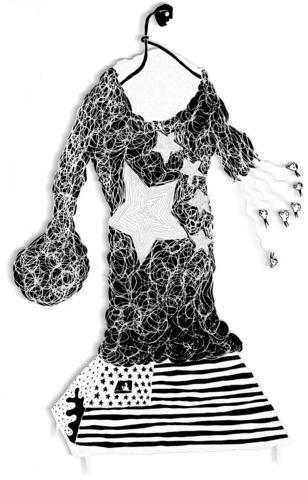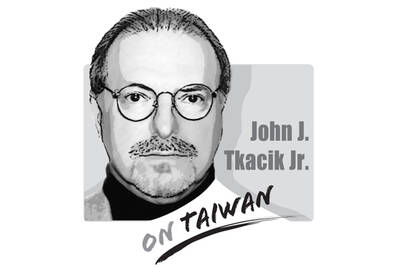The US government wasted little time in imposing safeguards for the country's textile manufacturers as they struggle to compete with a flood of new Chinese textile imports.
On Wednesday, the Committee for the Implementation of Textile Agreements (CITA), which the Department of Commerce chairs, added new categories of textile products to an already growing list of other textile products listed for protection last week.
The decisions are the US response to the expiration of WTO export quotas at the beginning of this year, which had effectively supported smaller textile industries around the world and limited giant producers such as China in what they could export. Since the expiration, total textile imports from China have increased 63 percent in the first quarter of the year compared to the same period last year, according to an estimate from the American Manufacturing Trade Action Coalition (AMTAC).

ILLUSTRATION: MOUNTAIN PEOPLE
But the new CITA limits, imposed in record time, specifically address categories of textiles where Chinese imports have soared up to 16 times in that short time, according to the National Council of Textile Organizations (NCTO).
Last week's ruling involved cotton knit shirts and blouses, cotton trousers, and cotton and man-made fiber underwear and the new safeguards approved on Wednesday would also protect shirts and trousers in other categories.
Secretary of Commerce Carlos Gutierrez said the decision to impose safeguards was made "based on market disruption and threat of market disruption due to the magnitude of increases in textile imports from China and China's significant capacity to increase production and exports to the US in these product categories."
He said putting up the safeguards shows that the US is committed to "leveling the playing field for US industry by enforcing our trade agreements."
But Senator Charles Schumer, an outspoken critic of China's trade policies, said he does not think that the department's actions go far enough.
"I don't think that answers the issue," Schumer said. "I don't think you look at this on a piece-by-piece basis. I think you look at the whole thing."
Senator Richard Burr, a Republican from North Carolina, which has a large textile industry and has been hit hard by the decline of domestic production, said the US puts together trade agreements "to transition to a predictable future and any time anybody doesn't play by the rules then that makes the future less predictable. I think that is the purpose of the safeguards."
Burr said he has urged the Commerce Department "to be vigilant from a standpoint of all the categories and if there is abuse by China or any other trading partner, we need to use the tools that we have to make sure that people live by the agreement."
Last week's safeguards were granted after an inflexible 30-day comment period ended May 9. But while CITA by law has up to 60 days to make its decision, it in fact acted within three days when it released its first set of decisions last week -- a performance that NCTO head Cass Johnson said was the fastest on record.
"Do you think that their minds were made up?" asked Laura Jones, executive director of the US Association of Importers of Textiles and Apparel.
Jones said it remains to be seen what the impact of the lifting of the quotas and imposing of safeguards will have in the long run, arguing that stakeholders are in a wait-and-see pattern to determine how the issue plays out.
But Johnson said putting in place safeguards would help US manufacturers and workers.
"The fast action to reimpose quotas by the Bush administration today has saved thousands of textile jobs in this country and we are extremely grateful," he said. "By expediting its decision-making process and moving quickly to impose safeguards, the US government sent a strong message that it understands the real crisis that these enormous surges present to our workers."
In another phenomenon that marked the quick US reaction, organized labor and US business groups, which rarely see eye to eye, are walking in lock step on the issue of textile imports from China.
Scott Paul, a legislative representative of the AFL-CIO said there "was a great amount of evidence that the lifting of the quotas harmed tens of thousands of workers in the US" and in other countries. He believed the action was "long overdue" and might be "too little, too late" to help thousands of workers.
US industry groups say China's illegal subsidies and currency manipulation are to blame for China's ability to flood the world's markets with textiles. On Tuesday, the US Treasury Department sharpened its message on the currency issue, and warned that China's practice of pegging the yuan to the dollar was "distortionary."
NCTO said that since the quotas were eliminated, more than 16,000 workers lost their jobs. The American Manufacturing Trade Action Coalition estimated that the industry has lost nearly 400,000 jobs, or 36.4 percent of the total workforce, since January 2001.
A Chinese diplomat’s violent threat against Japanese Prime Minister Sanae Takaichi following her remarks on defending Taiwan marks a dangerous escalation in East Asian tensions, revealing Beijing’s growing intolerance for dissent and the fragility of regional diplomacy. Chinese Consul General in Osaka Xue Jian (薛劍) on Saturday posted a chilling message on X: “the dirty neck that sticks itself in must be cut off,” in reference to Takaichi’s remark to Japanese lawmakers that an attack on Taiwan could threaten Japan’s survival. The post, which was later deleted, was not an isolated outburst. Xue has also amplified other incendiary messages, including one suggesting
Chinese Consul General in Osaka Xue Jian (薛劍) on Saturday last week shared a news article on social media about Japanese Prime Minister Sanae Takaichi’s remarks on Taiwan, adding that “the dirty neck that sticks itself in must be cut off.” The previous day in the Japanese House of Representatives, Takaichi said that a Chinese attack on Taiwan could constitute “a situation threatening Japan’s survival,” a reference to a legal legal term introduced in 2015 that allows the prime minister to deploy the Japan Self-Defense Forces. The violent nature of Xue’s comments is notable in that it came from a diplomat,
Before 1945, the most widely spoken language in Taiwan was Tai-gi (also known as Taiwanese, Taiwanese Hokkien or Hoklo). However, due to almost a century of language repression policies, many Taiwanese believe that Tai-gi is at risk of disappearing. To understand this crisis, I interviewed academics and activists about Taiwan’s history of language repression, the major challenges of revitalizing Tai-gi and their policy recommendations. Although Taiwanese were pressured to speak Japanese when Taiwan became a Japanese colony in 1895, most managed to keep their heritage languages alive in their homes. However, starting in 1949, when the Chinese Nationalist Party (KMT) enacted martial law

“Si ambulat loquitur tetrissitatque sicut anas, anas est” is, in customary international law, the three-part test of anatine ambulation, articulation and tetrissitation. And it is essential to Taiwan’s existence. Apocryphally, it can be traced as far back as Suetonius (蘇埃托尼烏斯) in late first-century Rome. Alas, Suetonius was only talking about ducks (anas). But this self-evident principle was codified as a four-part test at the Montevideo Convention in 1934, to which the United States is a party. Article One: “The state as a person of international law should possess the following qualifications: a) a permanent population; b) a defined territory; c) government;